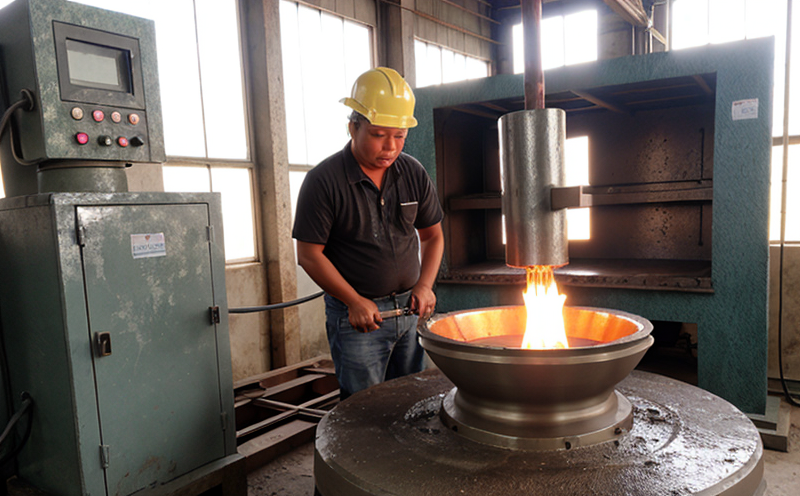ISO 8101 X Ray Testing of Castings
The ISO 8101 standard is a cornerstone in non-destructive testing (NDT) for castings, providing methods to inspect the internal structure and integrity of cast metal parts. This service ensures that industrial manufacturers can verify the quality and compliance with design specifications without compromising the integrity of the casting.
The process involves subjecting castings to X-ray imaging using specialized equipment, which allows for the visualization of internal defects such as cracks, porosity, shrinkage, and other anomalies. This method is particularly crucial in industrial manufacturing where the strength and reliability of components are paramount.
Compliance with ISO 8101 standards ensures that manufacturers adhere to international quality benchmarks. It helps in identifying potential flaws early in the production process, which can lead to significant cost savings by preventing the use of defective parts in end products. This service is ideal for sectors where precision and reliability are critical, such as automotive, aerospace, and construction.
The testing procedure begins with careful preparation of the casting. The casting must be clean and free from surface contaminants that could interfere with X-ray penetration. Once prepared, the casting is positioned in a suitable holder to ensure it remains stable during the imaging process.
Once the casting is properly set up, the operator uses an industrial X-ray machine to generate images of the internal structure. The choice of radiation energy and exposure time is critical for achieving clear and informative images. After acquiring the necessary images, the data is analyzed by a trained technician who looks for any signs of defects.
The results are then compiled into a detailed report that includes specifications such as defect size, location, and type. This information is crucial not only for quality assurance but also for process improvement initiatives within the manufacturing facility. The use of ISO 8101 X-ray testing ensures that manufacturers can meet stringent international standards, thereby enhancing their reputation in global markets.
Incorporating this service into your industrial processes allows you to maintain a high level of quality control and compliance, which is essential for maintaining customer satisfaction. By identifying defects early, you reduce the risk of costly rework or scrapped parts, thus optimizing production efficiency.
Why It Matters
The ISO 8101 X Ray Testing of Castings is critical in ensuring that industrial castings meet stringent quality standards and comply with international regulations. This testing method plays a vital role in minimizing the risk of product failures, which could lead to significant financial losses and safety hazards.
By using this service, manufacturers can verify the integrity of their castings before they are used in critical applications. This ensures that only defect-free parts enter the supply chain, thereby enhancing overall product reliability and performance. In sectors like aerospace and automotive, where safety is a top priority, such testing is non-negotiable.
The importance of this service cannot be overstated, especially given the increasing demand for high-quality industrial components. Compliance with ISO 8101 standards is not just about meeting regulatory requirements; it’s also about setting industry benchmarks that can drive innovation and excellence in manufacturing processes.
Why Choose This Test
- Precision in defect detection: The ISO 8101 X-ray testing method allows for the accurate identification of internal defects, ensuring that only high-quality castings are used.
- Non-destructive nature: Unlike destructive testing methods, this service does not alter or damage the casting, preserving its integrity for further use if needed.
- Compliance with international standards: By adhering to ISO 8101 specifications, manufacturers ensure that their products meet global quality benchmarks.
- Cost-effective: Early identification of defects can prevent costly rework or scrapped parts, optimizing production efficiency and reducing overall costs.
- Enhanced customer satisfaction: Providing defect-free castings enhances the reputation of the manufacturer in the market, leading to higher customer satisfaction and loyalty.
Customer Impact and Satisfaction
The use of ISO 8101 X-ray testing ensures that customers receive products that meet or exceed international quality standards. This service contributes significantly to customer satisfaction by delivering reliable, defect-free castings.
Manufacturers who invest in this testing method can build a strong reputation for quality and reliability, which is crucial in competitive markets. By ensuring that only compliant parts enter the supply chain, they demonstrate their commitment to excellence, thereby enhancing customer trust and loyalty.
The ability to comply with international standards not only meets regulatory requirements but also opens up new market opportunities. Customers in various industries, from aerospace to automotive, value consistency and reliability above all else, making ISO 8101 X-ray testing an invaluable asset for manufacturers.





